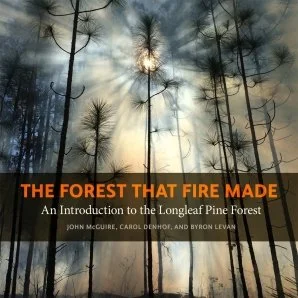The Forest That Fire Made by John McGuire, Carol Denhof & Byron Levan
Discover the environmental and cultural significance of the longleaf pine forest and its inhabitants.
The University of Georgia Press, 2023, https://ugapress.org.
The Sustainability Book Club met on January 4 to discuss The Forest That Fire Made: An Introduction to the Longleaf Pine Forest by John McGuire, Carol Denhof and Byron Levan. Longleaf pine forests are an iconic feature of the South and are found from Virginia to Texas. This book reveals the forests’ unique characteristics and diverse inhabitants as well as the ways humans have impacted them.
North Carolina has strong historical connections to the longleaf pine. It is believed that around 12 million acres of longleaf pine forests existed here in the 18th century. Harvesting of trees for naval stores—tar, pitch, turpentine and rosin—in the 1800s led to the growth of cities and helped North Carolina acquire its nickname, the Tar Heel State. The trees were also harvested for timber products, and many 19th-century operations stripped forests clean of trees. Only about 400,000 acres of longleaf pine forests remain today.
The Forest That Fire Made serves as an introduction to the longleaf pine forest and a field guide to the flora and fauna you can find there. Dependent on low-intensity surface fires for regeneration, this ecosystem supports both common and rare species, many of which have symbiotic relationships or specialized adaptations for living with frequent fire. One inhabitant, the gopher tortoise, digs deep underground burrows to escape fires and regulate temperature. Researchers have found that over 300 other species use these burrows! Another resident, the endangered red-cockaded woodpecker, excavates nest cavities exclusively in mature, living longleaf pines. The trees it selects are infected with red-heart disease, a fungus that softens the inner wood and makes excavation easier.
During the book club meeting, members discussed these interesting species as well as the role of fire in longleaf pine forests and human impacts throughout history. Beyond the book, there are lots of other resources to learn about these forests. Members talked about articles from The Nature Conservancy and educational videos on YouTube. The book club also reviewed some of the closest spots to see these iconic trees (see below).
Visit a Longleaf Pine Forest in North Carolina
The book lists locations throughout the South where you can find different types of longleaf pine forests. The sites are mostly open to the public, and the authors note exact coordinates and detailed instructions for reaching each site. Here are some locations in North Carolina:
Weymouth Woods Sandhills Nature Preserve, Moore County
Holly Shelter Game Lands, Pender County
Croatan National Forest, Carteret County
Carver's Creek State Park, Cumberland County
Sandhills Game Land, Richmond County
Bladen Lakes State Forest, Bladen County
Uwharrie National Forest, Montgomery County
Green Swamp Preserve, Brunswick County
Borrow or purchase a copy of The Forest That Fire Made to learn more about longleaf pines and plan a visit to see some!
The Sustainability Book Club
Join a small group of avid readers who meet monthly to engage in lively discussions focused on books about sustainability. The club meets at 6:30 p.m. on the first Thursday of every month on Zoom. Contact us to join!
Feb. 1: The Core of an Onion by Mark Kurlansky

